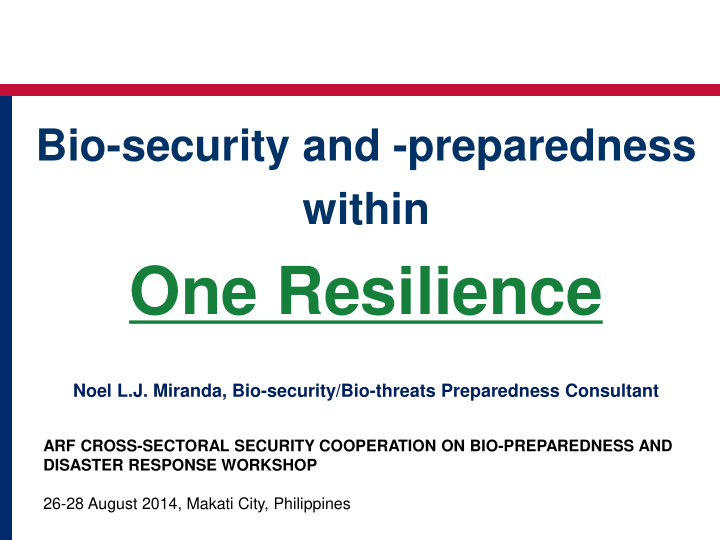



Bio-security and -preparedness within One Resilience Noel L.J. Miranda, Bio-security/Bio-threats Preparedness Consultant ARF CROSS-SECTORAL SECURITY COOPERATION ON BIO-PREPAREDNESS AND DISASTER RESPONSE WORKSHOP 26-28 August 2014, Makati City, Philippines
Whole-of-Society Approach Relatively more severe threats require a whole-of-society integrative risk management approach that emphasizes coordination and collaboration among all sectors
WoS Integrative Risk Management • sustainable all level preparedness to build capacities to respond to social disruptions, disunity and unrest that large-scale disasters (e.g. pandemics) generate. • aim to strengthen every part of society so that the whole system is better able to reduce risk, and respond to severe shocks such as massive absenteeism and disruptions • enable speedier re-establishment of normal life, business and livelihood.
One Resilience- “ Think and Work as ONE ” • Specifies the Rallying Points for the Whole-of- Society Integrative Risk Management Approach • Advocates the “ Think and Work as ONE ” Mentality or “ Think One Resilience ” – What can you do for me? – What can I do for you? – What concern of mine is also your concern? – What concern of yours is also my concern?
One Resilience- “ Think and Work as ONE ”
One Resilience- “ Think and Work as ONE ” • brings together independent approaches to resiliency ( SILOS )- where people and essential service sectors are drawn to support and depend on each other to build ROBUST families and communities that are able to contend with life ’ s challenges. • It drives Whole-of-Society to achieve Social, Health, Food and Energy Security through the strengthening of cross-sectoral dependency, where all service sectors think and work as ONE
One Resilience- “ Think and Work as ONE ” Poverty Reduction = Vulnerability Reduction • Health Security • Food and Water Security • Environmental protection and sustainable energy • Sustainable livelihood • Education and community outreach • Mass housing • Disaster risk reduction, mitigation and response • Public Safety and Security
One Resilience Leadership • OR Leadership is required to support governments and communities in coping with the impacts of threats and hazards, and be able to solve complex problems by instituting measures that drive whole-of-society to Think and Work as ONE
Disaster Spectrum: Opportunities for Innovation Early Warning/ Provision of Harm Protection Risk-Reduction: Essential Awareness- Services/Emergenc Build Better Tools-Devices Capacity Building …. y Relief: Pre-Disaster Disaster Hits Disaster Aftermath Post-Disaster (Peacetime to Alert (Continued Exposure to 2 ° Hazards) Stage) Personal Re-building Early Warning/ Risk- Disaster Reduction Harm Impact-Reduction PREVENTION-MITIGATION Protection RECOVERY PREPAREDNESS RESPONSE (Save Lives) (Reestablish Lives) for Disaster Impact-Reduction (Save More Lives) (Prevent Loss of Lives)
Disaster Aftermath Challenges • Disruption of basic and emergency health care • Dead bodies and lack of body bags • Maintenance of sanitation and hygiene • Discontinuity of essential services- Food and water, banking, transportation, telecommunications, and fuel/power supplies • Maintenance of peace and order
What Should We Strive for? • Continuity of essential services – prevent disruptions and minimize the impacts of disruptions • Effective emergency relief Relief becomes relevant only if services are disrupted- Services Continuity is a priority!
Organizational Considerations • Natural disasters, Human-induced (the CBRNE) and Pandemic Threats (ALL HAZARDS Approach) • Managed through a National Platform (e.g. NSC) and multi-sectoral-disciplinary Sub-platforms – Designate multidisciplinary rapid response teams ( RRTs ) [technical working groups (TWGs)] • Formulates preparedness and response (P&R) Frameworks and Plans • Responds to disaster events – Officially designate “ institutional disaster focal points ” from member organizations . – Clearly define links between authorities.
Sub-platform Leadership • Designate most technically qualified line agency as lead and oversight to address specific issues. – Department of Health- for public health consequences of a pandemic . – Department of Defense- Wide-scale Essential Services or Social Disruptions (e.g. nationwide riots and looting due to lack of medical supplies) – Jointly by the Departments of Health, Agriculture and Environment, under a One Health Sub-platform- for emergence of a newly detected zoonosis spreading rapidly in animal populations, and spilling- over to the human population
Sub-platforms • Stand-by “ ready-to-engage ” (through the RRT) specialized preparedness and response entities • Respond to specific disaster scenarios through the command of the most qualified line agency(ies). • Core structure and functions conform to the disaster scenario — from simple to very broad
ONE HEALTH The overall state-of-health of humans depends on the state-of- health of the entire ecosystem/society Any disruption in the ecosystem is a health hazard
Enabling Environment (To think about) • All-hazards (multi-impact) approach • National Platform (e.g. Non-Traditional Security Council) • Multi-sectoral-disciplinary sub-platforms • Designate qualified line agency as lead and oversight (sub-platform). • Designate multidisciplinary RRTs/ TWGs • Designate Institutional Disaster Focal Point(s) • Define links between authorities
One Resilience is a Grand Task • Requires strategic change in the mindset of leaders, civil servants and everyone involved in the building of society and communities- no discipline or concerned group should be marginalized, and sectoral silos should be eliminated. • Higher education must promote broad One Resilience objectives - i.e. absolute efficiency of systems is contingent on the interdependencies of sectoral approaches, and the capacity to enable strategic synergies.
Recommend
More recommend